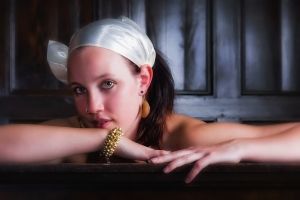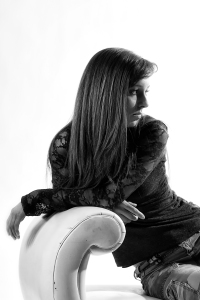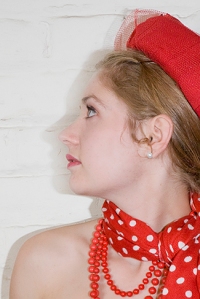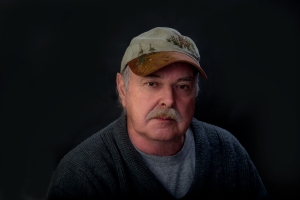Almost exactly a year ago I wrote an article titled, “Some Thoughts on Portrait Photography” and included a quote by Peter Brunnell the author of, “Creative Camera International 1977”. Brunnell wrote, “There is no single form or style of portraiture. Portraiture means individualism and as such means diversity, self-expression, private point of view. The most successful images seem to be those which exist on several planes at once and which reflect the fantasy and understanding of many.”
I remembered that blog post and decided to revisit it after having a discussion with friend and fellow photographer, Michael Beach this week about creative portraiture. We talked about several aspects of photographing people, but I think the topic we kept returning to was a about making portraits that had a different look and feel than other photographers in the town we both lived in.
In last February’s article I referred to my college photography instructor’s contention that we should always follow rules for portraiture. I won’t go into those at this time. I’ll just say they weren’t very imaginative and left little room for innovation or experimentation for that matter.
My argument with his lectures on portraiture, are that great portrait photographers like Irving Penn, Arnold Newman, Bert Stern, Yousuf Karsh, Richard Avedon, Eve Arnold, and Annie Leibovitz, to name a few that I like, were anything but rule followers, and what marked their work, as Brunnell wrote was, “individualism .…..self-expression, (and a) private point of view.” I did then, and still do think, that’s a lot for us mere-mortal photographers as we struggle to make our portraits something more than mere documentaries.
When I approach portraiture I try to create portraits that are, well, creative. Sometimes everything works and sometimes it doesn’t. However, I always strive for something different, maybe even unique, in each.
Of course, one must be aware of how our subject sees themselves and the circumstances and conditions under which the portrait is made. Using a word coined by Minor White, I think most successful portrait photographers “previsualze” the final portrait.
White, co-founder with Ansel Adams and Dorothea Lang of the influential photography magazine, Aperture, has been hailed as one of America’s greatest photographers. And regarding previsualization, Ansel Adams defined it as, “The ability to anticipate a finished image before making the exposure.”
I’ll ad another quote by Minor White that fits here and might be a good thought for a photographer about to pick up that camera to make a portrait, “One should not only photograph things for what they are but for what else they are.”
Sometimes it’s the expression on a subject’s face that makes the image. And to get that expression the photographer and subject may need to experiment with different moods and emotions. Portraitists spend much time putting people at ease and making them comfortable in front of a camera. I think it’s all about gaining a person’s trust that we are going to help them look the best they can.
The Internet is packed with “How to” advice on portraiture photography. Some of it is worth thinking about and some is bewildering. Those serious about bettering his or her portrait photography will select what works best and is the most comfortable.
A year ago I summed up with the following that worked for me then as it does now,
Everything comes down to one’s personal definition of what a portrait is. According to Wikipedia, “it is a picture of a person, a description. It can be a photograph, a sketch, a sculpture, but a portrait is so much more than that. It is collaboration between the subject and in this case the photographer.” Collaboration is the key word for me in that description, and in my experience those portraits I have made that I think are the most successful, is because the person who was in front of the camera was willing to work, or collaborate, with me towards the final image.
I always look forward to any comments. Thanks, John
My website is at www.enmanscamera.com





Interesting article. If we all followed the same rules on portraiture, it would get rather dull wouldn’t it? A portraiture is a collaboration between the subject and the photographer – I like that.
LikeLike
Thanks Lignum, I should have included the words, “TRENDS in portraiture” also…
I am glad you enjoyed my post this time. and I appreciate that you took the time to comment.
LikeLike
Thanks for your thoughts!
LikeLike
Glad you enjoyed my discussion. thanks for your comment.
LikeLike
While I enjoy the company women in every fashion ,I feel the last shot of the fella was a credit to modern photography .I see it as a shot in his environment ,like the story says ‘ this is me ‘
LikeLike
thanks Duncan. Yes, I also thought the photo of my friend was a good visual discussion. I like portraiture and my goal is always to flatter them. What sex, size or…well..whatever else about them, matters not. However, most viewers prefer a pretty woman….sex sells.
LikeLike
Very intriguing subject. Making quite a big leap of abstraction, you could say the same ‘rules’ and ‘non-rules’ apply for fiction writing, and sometimes I find the results of portraying a character are better when you place them in uncomfortable situations, to bring out the conflict. Though I guess that wouldn’t work the same with people before a camera, right?, unless the emotions you wanted to capture were dramatic.
LikeLike
I think there is not such a big leap Dimitris. Much of photography is fiction as the photographer stops time for that moment and if fortunate, creates something in the portrait that may be different than what that person want to present to the world.
With today’s technology photographers can more than ever before change a face. For example, I do staff portraits, and it is not that unusual to be asked, “can you fix this?” I whiten eyes & teeth. Remove blemishes and that sunburn from a day on the golf course. Get rid of the double chin…gosh, it goes on and on.
Fiction? Hell yes!
And regards to your thoughts about portraying character in conflict or uncomfortable situations for capturing emotions, you are right on. Look at the work of
Dorothea Lange’s Depression-era photography, Photojournalist Eve Arnold’s 1960 – The Misfits.
I don’t know what to say about Richard Avedon’s, The American West. The subjects aren’t under conflict, and I suppose were comfortable, but how did he get the tension I see in those images?
When I respond to some blogger that does Street Photography I always have some remark about the story I see. Just as I do when I read a good book or exciting poem, I want to make a story about that photograph.
LikeLike
I would add Karsh’s image of Churchill, taken in Ottawa. Karsh snatched the cigar away from Churchill and captured a glowering look which summed up Churchill’s character splendidly. Here’s the link: http://www.google.ca/url?sa=i&rct=j&q=&esrc=s&source=images&cd=&cad=rja&docid=5MRdwqeFikOVwM&tbnid=ktSXX8aLb1atVM:&ved=0CAUQjRw&url=http%3A%2F%2Ficonicphotos.wordpress.com%2F2009%2F07%2F31%2Fwinston-churchill-by-yousef-karsh%2F&ei=0ucCU4mjNM-JogTO2IAY&bvm=bv.61535280,d.cGU&psig=AFQjCNFX-yFizM5K9KqHEFr7tswv77-KlQ&ust=1392785726067656
LikeLike
Yes, of course Derek. I expect there are many, like Mr. Karsh, that I could have added. Thanks.
LikeLike
Ah, that’s brilliant. I’m not very knowledgeable in the field of photography so just went by instinct. (Thanks for the suggestions, I’m on my way to check them out.) It struck me that the way you talk about your art is similar to talking about fiction; of course, both photography and writing consist of narrative, but in fiction this seems to constantly evolve as the work changes inwardly (from beginning to end), while with photography the narrative is more… static (not in a negative way), as in, it’s the encapsulation of the narrative which the viewer can then imagine further and expand in his/her own mind, and so, more compact for this. But I’m thinking, I tend to get ideas for character development often from acting manuals or books on directing, so why not extract from the same vein of inspiration from photography too! I wonder if this could also work the other way round. Narrative is boundless and it pays to expand your horizons. So, thank you for your thoughts. I enjoy your work (I looked at your site), keep ‘writing’. : )
LikeLike